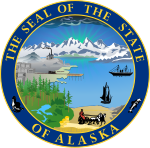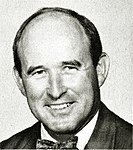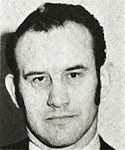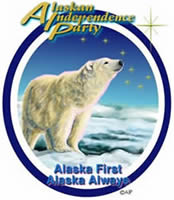
The Alaskan Independence Party (AIP) is an Alaskan nationalist political party in the United States that advocates for an in-state referendum which would include the option of Alaska becoming an independent country. The party also advocates positions similar to those of the Constitution Party, Republican Party and Libertarian Party, supporting gun rights, anti-abortion policies, privatization, homeschooling, and limited government.
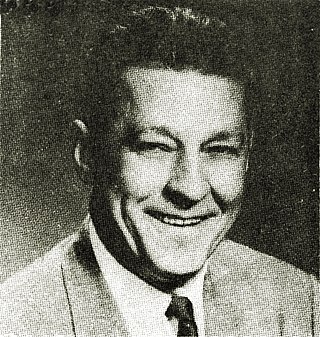
Joseph E. Vogler was the founder of the Alaskan Independence Party. He was also chair or gubernatorial nominee during most of the party's existence. He was also known, originally in his adopted hometown of Fairbanks, Alaska, and later statewide, as a frequent participant in governmental and political affairs and frequent litigant in court. Curiously enough, he was known to many non-political observers for his fashion sense, in particular his ubiquitous wearing of fedoras and bolo ties.

United States gubernatorial elections were held on November 5, 2002, in 36 states and two territories. The Republicans won eight seats previously held by the Democrats, as well as the seat previously held by Minnesota governor Jesse Ventura, who was elected on the Reform Party ticket but had since renounced his party affiliation. The Democrats won 10 seats previously held by the Republicans, as well as the seat previously held by Maine governor Angus King, an independent. The elections were held concurrently with the other United States elections of 2002.
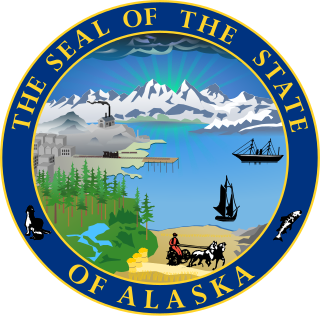
The number of elections in Alaska varies by year, but typically municipal elections occur every year, plus primary and general elections for federal and state offices occur during even-numbered years. Alaska has a gubernatorial election every four years. Members of the state's United States congressional delegation run for election or re-election at the times set out in the United States Constitution. Primary elections assist in choosing political parties' nominees for various positions. On a regional basis, elections also cover municipal issues. In addition, a special election can occur at any time.
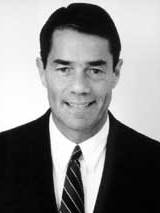
The 1994 Alaska gubernatorial election took place on November 8, 1994, for the post of Governor of Alaska, United States. Democratic candidate Tony Knowles narrowly defeated Republican candidate Jim Campbell and Lieutenant Governor Jack Coghill of the Alaskan Independence Party. In the Republican Revolution year of the 1994 elections, Alaska's was the only governor's seat in the country to switch from Republican to Democratic.

Richard L. Randolph is a longtime insurance agency owner in Fairbanks, Alaska who is best known as the first person to be elected to partisan office under the banner of the Libertarian Party with his election to the Alaska House of Representatives in 1978. He was re-elected in 1980. After Alaska greatly increased its revenue from the development of oil, Randolph advocated the repeal of the state income tax. The effort was successful, with Alaska being one of only two states where residents pay neither an income nor a sales tax—the other being New Hampshire. He was also the LP's gubernatorial nominee in 1982, garnering nearly 15 percent of the vote.
The Libertarian Party of the United States was formed in Colorado Springs in the home of Luke Zell by a group of individuals led by David Nolan on December 11, 1971, after several months of debate among members of the Committee to Form a Libertarian Party, founded July 17. The formation was prompted in part by price controls and the end of the Gold Standard implemented by President Richard Nixon. The Libertarian Party viewed the dominant Republican and Democratic parties as having diverged from what they viewed as the libertarian principles of the American Founding Fathers. This group included John Hospers, Edward Crane, Manuel Klausner, Murray Rothbard, Roy Childs, D. Frank Robinson, Theodora (Tonie) Nathan, and Jim Dean.

The 2010 Illinois gubernatorial election took place on November 2, 2010. Incumbent Democratic Governor Pat Quinn was elected to a full term in office, having become governor in 2009 following the impeachment and removal of Governor Rod Blagojevich. Quinn was elected as the Democratic nominee, the Illinois Green Party nominee was attorney and 2006 nominee Rich Whitney, the Republican nominee was State Senator Bill Brady, the Libertarian Party nominee was Lex Green, and Scott Lee Cohen ran as an independent.

The 2010 Alaska gubernatorial election took place on November 2, 2010. Former Governor Sarah Palin did not run, having resigned in July 2009. Incumbent Governor Sean Parnell, who as lieutenant governor succeeded Palin following her resignation, announced that he would seek a full term.
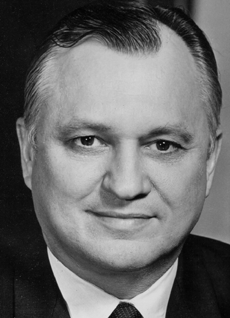
The 1990 Alaska gubernatorial election took place on November 6, 1990, for the open seat of Governor of Alaska. In 1989, incumbent Governor Steve Cowper, a Democrat, had announced that he would not seek re-election for a second term.
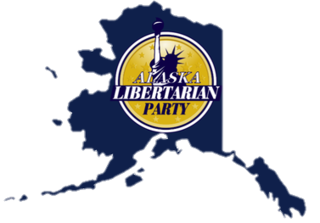
The Libertarian Party of Alaska is the affiliate of the Libertarian Party (LP) in Alaska, headquartered in Anchorage.

The 1986 Illinois gubernatorial election was held on November 4, 1986. Republican candidate James R. Thompson won a fourth term in office, defeating the Illinois Solidarity Party nominee, former United States Senator Adlai Stevenson III, by around 400,000 votes.
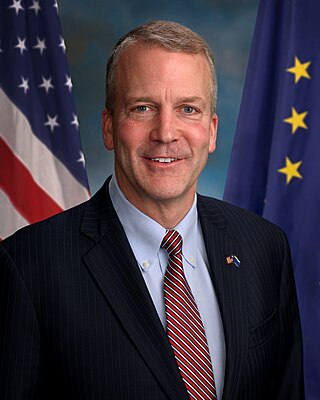
The 2014 United States Senate election in Alaska took place on November 4, 2014, to elect a member of the United States Senate to represent the State of Alaska, concurrently with the election of the governor of Alaska, as well as other elections to the United States Senate in other states and elections to the United States House of Representatives and various state and local elections.

The 1986 Alaska gubernatorial election took place on November 4, 1986, for the post of Governor of Alaska. Incumbent Governor Bill Sheffield, a Democrat who was seeking re-election, was defeated by Steve Cowper in the Democratic primary election on August 26, 1986.
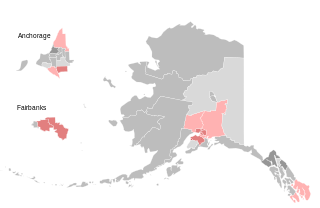
The 2014 Alaska gubernatorial election took place on November 4, 2014, to elect the governor and lieutenant governor of Alaska, concurrently with the election of Alaska's Class II U.S. Senate seat, as well as other elections to the United States Senate in other states and elections to the United States House of Representatives and various state and local elections.

United States gubernatorial elections were held on November 7, 2017, in two states: Virginia and New Jersey. These elections formed part of the 2017 United States elections. The last regular gubernatorial elections for these two states were in 2013. Both incumbents were term-limited, so both seats were open. Democrats held the governorship in Virginia and picked up the governorship of New Jersey.

The 1978 Alaska gubernatorial election took place on November 7, 1978, for the post of governor of Alaska. Republican incumbent Jay Hammond defeated four opponents: former Governor of Alaska and write-in candidate Wally Hickel, Alaska Senator and Democratic nominee Chancy Croft, former Commissioner of Natural Resources and Independent candidate Tom Kelly and Alaskan Independence Party nominee Don Wright. After losing to Hammond in the Republican primary, Hickel ran as a write-in candidate and was able to outperform Croft. Republican Tom Fink and Democrat Jay Kerttula also ran in the open primary.

United States gubernatorial elections were held on November 6, 2018, in 36 states and three territories. These elections formed part of the 2018 United States elections. Other coinciding elections were the 2018 United States Senate elections and the 2018 United States House of Representatives elections.

The 2018 Alaska gubernatorial election took place on November 6, 2018, to elect the governor and lieutenant governor of Alaska. In the primaries for recognized political parties, candidates for governor and lieutenant governor run separately. The winners of each respective primary for governor and lieutenant governor then become a joint ticket in the general election for their political party. Incumbent independent governor Bill Walker was running for re-election in what was originally a three-way race between Walker, Republican former state senator Mike Dunleavy, and Democratic nominee Mark Begich, a former U.S. Senator. However, Walker dropped out on October 19, 2018, and endorsed Begich. In spite of Walker dropping out, Dunleavy defeated Begich in what would become the only gubernatorial gain by a Republican candidate in 2018. Walker later unsuccessfully ran for Governor of Alaska in 2022.

United States gubernatorial elections were held on November 8, 2022, in 36 states and three territories. As most governors serve four-year terms, the last regular gubernatorial elections for all but two of the seats took place in 2018 U.S. gubernatorial elections. The gubernatorial elections took place concurrently with several other federal, state, and local elections, as part of the 2022 midterm elections.

